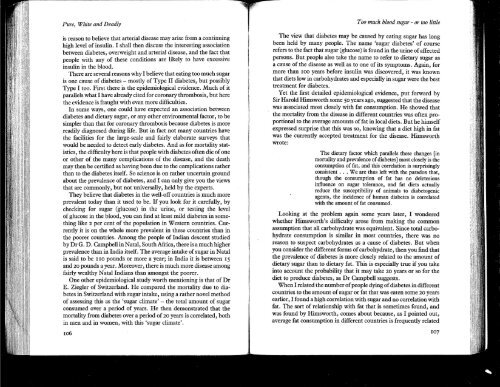John_Yudkin_-_Pure_White_and_Deadly_revised_1986_OCR
John_Yudkin_-_Pure_White_and_Deadly_revised_1986_OCR
John_Yudkin_-_Pure_White_and_Deadly_revised_1986_OCR
You also want an ePaper? Increase the reach of your titles
YUMPU automatically turns print PDFs into web optimized ePapers that Google loves.
<strong>Pure</strong>, <strong>White</strong> <strong>and</strong> <strong>Deadly</strong><br />
is reason to believe that arterial disease may arise from a continuing<br />
high level of insulin. I shall then discuss the interesting association<br />
between diabetes, overweight <strong>and</strong> arterial disease, <strong>and</strong> the fact that<br />
people with any of these conditions are likely to have excessive<br />
insulin in the blood.<br />
There are several reasons why I believe that eating too much sugar<br />
is one cause of diabetes - mostly of Type II diabetes, but possibly<br />
Type I too. First there is the epidemiological evidence. Much of it<br />
parallels what I have already cited for coronary thrombosis, but here<br />
the evidence is fraught with even more difficulties.<br />
In some ways, one could have expected an association between<br />
diabetes <strong>and</strong> dietary sugar, or any other environmental factor, to be<br />
simpler than that for coronary thrombosis because diabetes is more<br />
readily diagnosed during life. But in fact not many countries have<br />
the facilities for the large-scale <strong>and</strong> fairly elaborate surveys that<br />
would be needed to detect early diabetes. And as for mortality statistics,<br />
the difficulty here is that people with diabetes often die of one<br />
or other of the many complications of the disease, <strong>and</strong> the death<br />
may then be certified as having been due to the complications rather<br />
than to the diabetes itself. So science is on rather uncertain ground<br />
about the prevalence of diabetes, <strong>and</strong> I can only give you the views<br />
that are commonly, but not universally, held by the experts.<br />
They believe that diabetes in the well-off countries is much more<br />
prevalent today than it used to be. If you look for it carefully, by<br />
checking for sugar (glucose) in the urine, or testing the level<br />
of glucose in the blood, you can find at least mild diabetes in something<br />
like 2 per cent of the popUlation in Western countries. Currently<br />
it is on the whole more prevalent in these countries than in<br />
the poorer countries. Among the people of Indian descent studied<br />
by Dr G. D. Campbell in Natal, South Mrica, there is a much higher<br />
prevalence than in India itself. The average intake of sugar in Natal<br />
is said to be IIO pounds or more a year; in India it is between 15<br />
<strong>and</strong> 20 pounds a year. Moreover, there is much more disease among<br />
fairly wealthy Natal Indians than amongst the poorer.<br />
One other epidemiological study worth mentioning is that of Dr<br />
E. Ziegler of Switzerl<strong>and</strong>. He compared the mortality due to diabetes<br />
in Switzerl<strong>and</strong> with sugar intake, using a rather novel method<br />
of assessing this as the 'sugar climate' - the total amount of sugar<br />
consumed over a period of years. He then demonstrated that the<br />
mortality from diabetes over a period of 20 years is correlated, both<br />
in men <strong>and</strong> in women, with this 'sugar climate'.<br />
106<br />
Too much blood sugar - or too little<br />
The view that diabetes may be caused by eating sugar has long<br />
been held by many people. The name 'sugar diabetes' of course<br />
refers to the fact that sugar (glucose) is found in the urine of affected<br />
persons. But people also take the name to refer to dietary sugar as<br />
a cause of the disease as well as to one of its symptoms. Again, for<br />
more than 100 years before insulin was discovered, it was known<br />
that diets low in carbohydrates <strong>and</strong> especially in sugar were the best<br />
treatment for diabetes.<br />
Yet the first detailed epidemiological evidence, put forward by<br />
Sir Harold Himsworth some 50 years ago, suggested that the disease<br />
was associated most closely with fat consumption. He showed that<br />
the mortality from the disease in different couritries was often proportional<br />
to the average amounts of fat in local diets. But he himself<br />
expressed surprise that this was so, knowing that a diet high in fat<br />
was the currently accepted treatment for the disease. Himsworth<br />
wrote:<br />
The dietary factor which parallels these changes [in<br />
mortality <strong>and</strong> prevalence of diabetes] most closely is the<br />
consumption of fat, <strong>and</strong> this correlation is surprisingly<br />
consistent ••. We are thus left with the paradox that,<br />
though the consumption of fat has no deleterious<br />
influence on sugar tolerance, <strong>and</strong> fat diets actually<br />
reduce the susceptibility of animals to diabetogenic<br />
agents, the incidence of human diabetes is correlated<br />
with the amount off at consumed.<br />
Looking at the problem again some years later, I wondered<br />
whether Himsworth's difficulty arose from making the common<br />
assumption that all carbohydrate was equivalent. Since total carbohydrate<br />
consumption is similar in most countries, there was no<br />
reason to suspect carbohydrates as a cause of diabetes. But when<br />
you consider the different forms of carbohydrate, then you find that<br />
the prevalence of diabetes is more closely related to the amount of<br />
dietary sugar than to dietary fat. This is especially true if you take<br />
into account the probability that it may take 20 years or so for the<br />
diet to produce diabetes, as Dr Campbell suggests.<br />
When I related the number of people dying of diabetes in different<br />
countries to the amount of sugar or fat that was eaten some 20 years<br />
earlier, I found a high correlation with sugar <strong>and</strong> no correlation with<br />
fat. The sort of relationship with fat that is sometimes found, <strong>and</strong><br />
was found by Himsworth, comes about because, as I pointed out,<br />
average fat consumption in different countries is frequently related<br />
107



